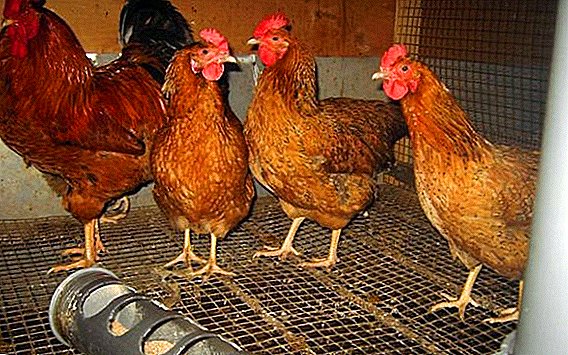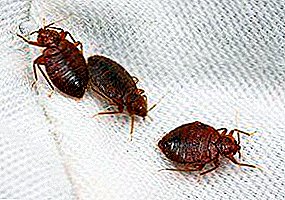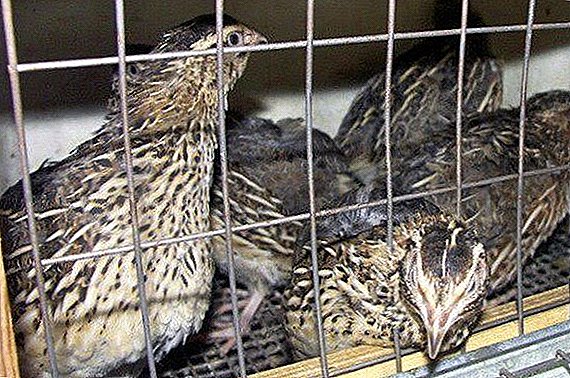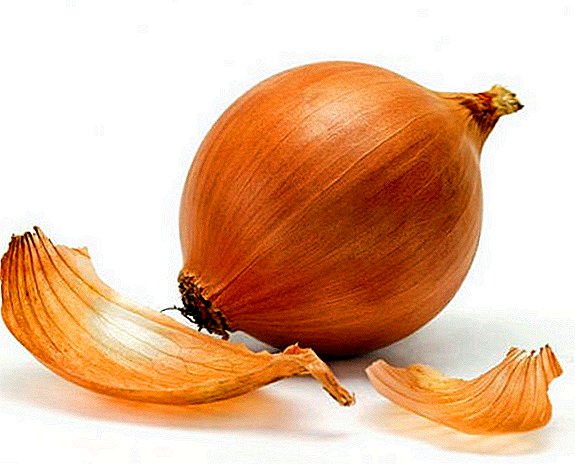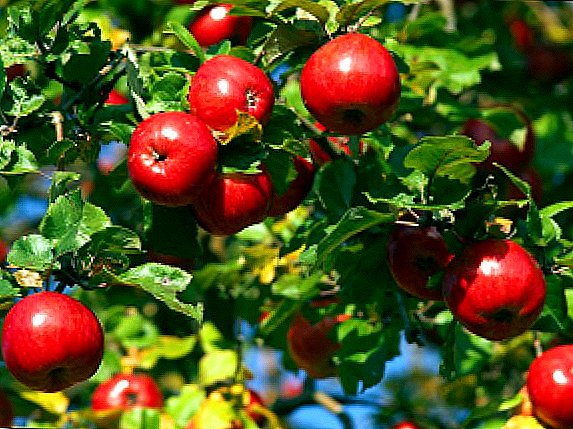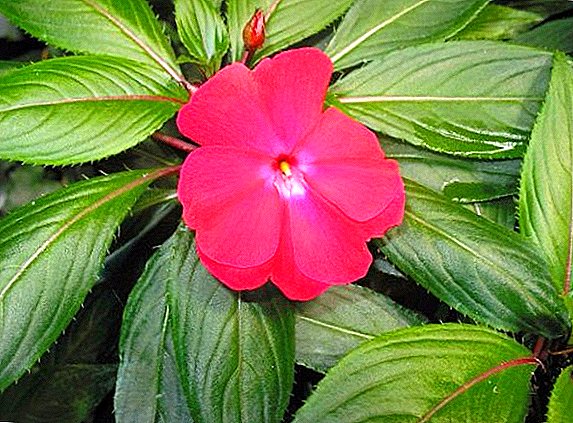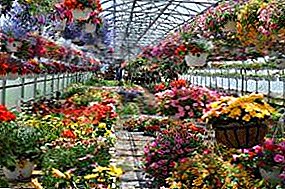 Red-sided apples of the winter variety "Antey" are distinguished by a pleasant taste, weight and excellent keeping quality. In a dry cellar with good ventilation, they can last six months. At the same time, the skin will not lose its elasticity, and the flesh will remain as juicy as if the fruit had just been removed from the tree. What other characteristics a variety has, how to acquire it and successfully grow it on your own plot - we will tell about it later in the article.
Red-sided apples of the winter variety "Antey" are distinguished by a pleasant taste, weight and excellent keeping quality. In a dry cellar with good ventilation, they can last six months. At the same time, the skin will not lose its elasticity, and the flesh will remain as juicy as if the fruit had just been removed from the tree. What other characteristics a variety has, how to acquire it and successfully grow it on your own plot - we will tell about it later in the article.
Breeding history
The winter apple tree "Antey" is a gift from the specialists of the Belarusian Research Institute to domestic gardeners. Breeders dreamed of creating a large-fruited apple with increased resistance to cold climatic conditions.
The progenitors of the variety are Apple cuttings “Newtosh” and “Babushkino”. The hybrid that grew from them was later crossed with the Belarusian Raspberry. In the process of hybridization, the apple tree was tested in severe winters and lack of elementary care.  Botanists deliberately deprived of all this apple tree to test its true vitality.
Botanists deliberately deprived of all this apple tree to test its true vitality.
Did you know? In Europe, Poland is the largest exporter of apples, and the world championship went to the People's Republic of China.
As a result of painstaking work and long improvements, a new variety was developed, to the main advantages of which frost resistance, stable yield, excellent taste and commodity qualities of fruits, supersweakness are credited.
More than 20 years ago, the apple tree "Antey" for such a positive description of the variety was added to the State Register of tree and handicraft varieties of Belarus as particularly valuable and productive.
Characteristic variety
The hybrid has incorporated the best parental qualities, due to which it adequately competes in the fruit market among winter varieties.
Consider what is special in the apple tree "Antey", why the description, photos and reviews about it encourage gardeners to get such a seedling.
Tree description
Externally, "Antey" is a medium-growth tree, the maximum height of which reaches 2.5 meters. Its branches form a rounded pyramid with distinct tiers.
Young shoots grow intensively, but do not thicken the crown, which greatly facilitates the care of the apple tree. The foliage on the tree is large, dark green, egg-shaped.
The edges of the sheet plate are notched, the tip is pointed, the surface is densely covered with streaks. Scapes on the leaves are long, which visually creates the effect of a strongly leafy crown.
Important! Apple trees do not develop well on acidic substrates. Therefore, when choosing a site for planting, be sure to test the area for soil acidity. At home, it’s enough to drop a few drops of 9% vinegar on a handful of earth. The absence of hissing and bubbling indicates the need to deoxidize the soil. This is done using lime, dolomite flour or cement dust.
 Experts qualify the variety for skoroplodnymi, as the two-year-old seedlings "Antey" begin to bloom and bear fruit. But many gardeners do not allow this, allowing the tree to get stronger.
Experts qualify the variety for skoroplodnymi, as the two-year-old seedlings "Antey" begin to bloom and bear fruit. But many gardeners do not allow this, allowing the tree to get stronger.The first inflorescences open in mid-May. Often, flowers appear on kolchatka. A characteristic feature of the apple is the annual regular planting of fruit buds.
Among the worthy qualities of "Anthea" - unpretentious care, easy adaptation to cold.
Winter-hardy are also such varieties of apples: "Moscow pear", "Cinnamon striped", "Silver hoof", "Antonovka" and "Sunrise".
Fruit Description
The value of the fruits of the hybrid lies in their excellent taste characteristics, large size, delicious color and unsurpassed keeping quality. In the market "Antey" can be recognized by size.
In the eyes immediately catch the red side of a large fruit. On average, one apple weighs in the range of 200-250 g. The fruits have the shape of a blunt cone with smooth edges. Practically always a deep funnel grows brown on the fruit near the oblique stem.
To the best of ripening, the green background of the fruit is thickly covered with a purple-red blush, evenly filling the entire surface. A bluish sheen gives it a typical wax coating for winter varieties.
Did you know? In a small apple 80 kilocalories.
 Inside the fruit "Anthea" have a slightly greenish tint. The pulp is thick and juicy, the kernels are large. Among the chemical components of apples, dry fibers (13%), pectin (12%), sugars (10%), carbohydrates (9%), titrated acid (0.7%), proteins (0.4%) prevail.
Inside the fruit "Anthea" have a slightly greenish tint. The pulp is thick and juicy, the kernels are large. Among the chemical components of apples, dry fibers (13%), pectin (12%), sugars (10%), carbohydrates (9%), titrated acid (0.7%), proteins (0.4%) prevail.Ascorbic acid and P-active substances are also available. The taste of fruit is sweet and sour, have a delicate pleasant aroma. Tasters rated them on a five-point scale by 4.3 points.
Pollination
Despite the abundant flowering, the hybrid is self-productive, so it is desirable to place it on a plot with other autumn varieties. Breeders as the best pollinators recommend "Anise", "Pepin saffron", "Welsey", "Autumn striped".
Poor pollination is noted in the vicinity of winter varieties. Also next to the "Antey" will be ineffective "White filling" or other summer apple trees.
Gestation period
Harvesting with apples can be throughout September. By this period, the fruits are filled with blush and reach their consumer maturity. In the cold summer season, ripeness is slightly delayed until the second decade of October.  In addition, apples during storage do not require additional processing or any other tricks. 2 months after laying in the storage the fruits become even sweeter.
In addition, apples during storage do not require additional processing or any other tricks. 2 months after laying in the storage the fruits become even sweeter.
Important! Coniferous materials are not recommended to be used for mulching pristvolny holes under the apple trees. The fact is that such a mulch oxidizes the soil, which is very undesirable for a fruit tree.
Yield
Due to the fact that the fruit buds are formed on the "Antea" with enviable regularity regardless of weather conditions, the variety is characterized by abundant fruiting. The tree enters this phase already on the 2-3rd year of life.
For hybrid varieties, these terms are considered quite normal. But gardeners often tear off the first inflorescences so that the plant is not depleted. At the next flowering, no more than a dozen buds are left, after which they no longer intervene in the fruit formation process.
Three-year seedlings already delight their owners fragrant fruit. From one tree is quite realistic to remove up to 50 kg of the crop. Thanks to these qualities, "Antey" ranked as commercial varieties. 
Transportability and storage
Fruits of a hybrid are covered with a firm elastic skin that simplifies transportation, and the dense pulp is almost not damaged at the same time. Like all winter apples, they must be carefully removed from the branches and in no case should the trunk be braked so that they fall to the ground.
For harvesting, you can stock up on purchased special devices or make them at home by tying the cut-off bottom from a plastic bottle to a long stick. This primitive method allows the fruit to maintain integrity.
For transportation, fruit is best folded in wooden or plastic boxes. If you are already very worried about the harvest, you can shift the fruit with straw or pack it separately into paper. But this is not necessary, since “Antey” is characterized by good transportability.
Did you know? The oldest apple tree in the world grows in Manhattan. In 1647, it was planted by the American Peter Stuvensant. Much to the surprise, compared to modern hybrids, the life expectancy of which barely reaches half a century, the 370-year-old "old woman" continues to produce crops.
 After harvesting, boxes of apples are sent to the storage in the cellar. It is important that there is dry, because in the damp any fruit will not be able to lie for a long time. In no case can not wipe the skin with alcohol or other disinfectants.
After harvesting, boxes of apples are sent to the storage in the cellar. It is important that there is dry, because in the damp any fruit will not be able to lie for a long time. In no case can not wipe the skin with alcohol or other disinfectants.This is fraught with the fact that the fetus will lose its natural protection, which is a wax coating. It is he who protects the apple from the penetration of pathogenic microorganisms.
Winter hardiness
The genetic characteristics of the progenitors and the conditions of hybridization have already determined the high rates of winter hardiness of the variety. The hybrid can even develop in regions where the thermometer drops to 30 degrees every winter.
Cold and dampness is also not an obstacle for “Antey”. Therefore, the tree will bear fruit in any climatic latitudes. In addition, the apple tree is normally experiencing spring frosts, and the timing of its flowering excludes the possibility of destroying the buds.
Important! Before planting apple seedlings, it is advisable to treat the rhizomes with phytohormones. The procedure will serve as a stimulus for the active development of the root system and rapid rooting.

Disease and pest resistance
The weak side of the variety can be called the average immunity to scab and powdery mildew. The tree quickly undergoes attacks by malicious insects, which requires timely preventive sprinkling.
In addition, in the soil where there is little calcium, the tree is often exposed to subcutaneous blotch infection. Recognize the disease can be on the sudden rotting of the fruit.
Application
Many cultivate a variety for profit, since it does not require a lot of expenses, is easy to maintain and pays for all the resources invested in it in a hundredfold amount. In the household, Antey is often used to provide the family with fresh fruit in the winter.
Moreover, the apples are well and in favorable conditions may, without losing presentability and taste, persist until May. Some housewives send them for processing and home canning. Breeders in the description of the variety mention the universality of its fruits.
Important! When buying an apple tree seedling, carefully inspect the roots, trunk and root collar. On a healthy planting material there should not be any mechanical damage, overflows, gall formations, mold and any other spots, putrefactive areas. Ideally, the choice should fall on a half meter tree with a healthy strong root, a powerful, even trunk and 5 skeletal branches.

Rules for planting apple seedlings
Separate rules for the apple "Antey" during planting and care does not exist. They are the same as for other varieties. It is important to comply with them, since the acquisition of a healthy seedling is only half of the successful cultivation of fruit crops, the rest depends on the rooting process and the conditions created for development. We will understand all the nuances in order.
Optimal timing
In order to correctly plan the planting, be guided by the age of the seedlings. Experts recommend too young saplings before the age of two to root in the spring, and all other specimens, except the old, in the fall.
According to scientists, spring planting is recommended for more delicate crops, summer and autumn varieties of fruit trees, which need time to adapt to winter conditions. It is believed that during the warm season, the seedlings will strengthen the root system and increase the first increments, which will allow to winter.
The only drawback of spring planting is the risk of dry in the hot summer. Consequently, the tree needs frequent watering, and when planting it is necessary to pour water until it goes into the ground.
Important! To prevent apples from rotting in the cellar, treat the crown with phosphorus six weeks before the harvest.
 Planting work should begin when the earth is warm enough, and the daytime temperature rises to a stable 14-15 degrees. The optimal dates for spring are considered the last 2 decades of April.
Planting work should begin when the earth is warm enough, and the daytime temperature rises to a stable 14-15 degrees. The optimal dates for spring are considered the last 2 decades of April.Winter varieties of apple trees easily adapt to new conditions during autumn plantings. The main thing in this case - time to hold rooting a few weeks before the first frost. The tree needs at least a short period to master.
At the same time, it does not need regular soil moistening, it is not threatened by the drying of the roots. During the period of tranquility in wet soil, the apple tree will grow many root processes and with the onset of heat it will begin to grow intensively. Given the characteristics of the temperate climate zone, the second half of October is the best period for planting apple trees.
Read the best recipes for harvesting apples for the winter.
Location selection
For the further development of the apple tree "Antey" lighting, location of groundwater and soil conditions is important. Proceeding from this, when choosing a site, stop at a chernozem area with a neutral pH reaction, where there are no marshy and rocky areas, spring does not gather melt snow and do not stand puddles.
Underground reservoirs ideally should flow at a distance of 2 m from the surface layer. Do not plan on planting in a shady place; in such conditions, an apple tree will “sit” for a long time without growth, and the crop will not impress you at all either in quantity or quality.  So that the tree does not suffer from a lack of lighting, choose a place for it, which is illuminated for at least half a day with diffused light.
So that the tree does not suffer from a lack of lighting, choose a place for it, which is illuminated for at least half a day with diffused light.
Did you know? Regular consumption of apples helps to strengthen the immune system, gives vitality and energy.Apple does not fit:
- elevations where it is always hot;
- lowlands, where cold air settles;
- corners of rooms where northern winds blow and drafts walk.
Stepwise landing process
A hole for the apple is dug a month before planting, and in the case of spring rooting - in the fall. The size of the recess should correspond to the root system, often it is 70 cm deep and 90 cm wide. Then prepare a special soil mixture from equal portions of peat, humus, compost and the top layer of fertile land.
The bottom of the hole is lined with claydite, and the top is covered with a third of the prepared substrate. From above cover with a film and leave to landing. In the process of rooting, experts advise:
- Before work, inspect the seedling, remove dry and damaged parts.
- Dip the tree roots for 12 hours in a container with water, in which it is desirable to add a growth stimulator.
- After the procedure, treat the roots with clay mash.
- Put the seedling in the prepared pit and straighten it.
- Cover with soil, properly rammed. It is advisable to shake the trunk several times so that the earth will fill up the voids between the root processes.
- Water the tree and sprinkle with soil.
Important! The root neck of the planted tree should rise 4-5 cm above the ground.Plan the planting of "Anthea" in such a way that the distance between the apple trees is 1.5 m, and between the rows is 4 m.
Seasonal care features
During the growing season, an apple tree requires nutrients, a moderate amount of water, crown adjustment, and soil care.
The abundance of irrigation
Young seedlings need to be watered much more often than mature apples. Plan your first watering in the spring before bud break and repeat the soil moistening after 2-3 weeks. The second watering for adult plants is done when they have faded, as well as during the growth of greenfinches.  The last water procedure is desirable to spend a few weeks before harvest.
The last water procedure is desirable to spend a few weeks before harvest.
The rate of water poured under each tree depends on its age: 2 buckets are enough for one-year seedlings, 3-4 buckets for two-year-olds, and 6 to 10 buckets for older ones.
The role of mulch
Each watering should end with tillage in pristvolnyh circles. It is important to loosen and clean it from weeds in time. In order not to evaporate moisture and weeds did not grow, experienced owners lay out hay or other mulch under the trees.
It is important to retreat from the trunks of 10-15 cm. Otherwise, microorganisms that appear in the decomposing material will easily penetrate the roots of the tree, which at best will lead to its diseases.
Did you know? Apple peel contains a third of antioxidants and fiber.
Top dressing
With the beginning of the active growth of the apple watered infusion of chicken manure to build green mass. During the formation of the ovary, the tree will be very helpful in a solution of nitroammofoski, ammonium nitrate (1 tablespoon), calcium chloride (1.5 tablespoons) and superphosphate (150 g).
All ingredients need to be dissolved in a bucket of water. The following feeding is important at the end of the summer. In order to prepare the apple for the winter, it is desirable to fertilize it with autumn mineral complexes or a solution of superphosphate (50 g per 1 l of water).
Preventive treatment
In the case of "Antey" do not wait for the first signs of disease, it is better to work ahead of the curve. To do this, sprinkle the apple tree with a solution of copper sulfate (50 g per 1 l) in early spring.
An alternative to it are the drugs: "Albite", "Skor", "Hom", which must be diluted in accordance with the recommendations of the manufacturers.
Cropping and crown formation
The crown of the hybrid does not require a strong pruning, because it is not prone to intense thickening. However, each spring, before the start of sap flow, it is necessary to remove old and diseased branches from the tree, clean it from competing shoots, leaving it stronger.
Ideally, the lower layer of branches should consist of the growth of the third year, on the apple tree all shoots should receive uniform coverage and not cast a shadow on each other. The cutoff point is slightly higher than the third peephole. When forming the crown, do not forget to rejuvenate its core. 
Important! One-year increments reaching 30 cm in length and ending in a bud of buds are not recommended to be cut..
Preparing for the winter
Only young, not yet mature seedlings need shelter for the winter. Their tree trunks are covered with humus or compost mulch, and the trunk and branches are wrapped in a thick cloth. Adult apples will need to be protected from rodents.
To do this, you can hide the trunk behind a fine mesh, tolley or spruce branches. Apple trees "Antey" in a few years will thank you for elementary care with a good harvest, from which you can make a profit if you wish.


